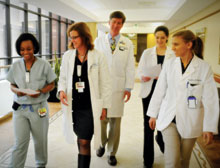Setting the Record Straight for Students
By Rosalind Fournier
 |
Alice Goepfert and Brian Gleason (second and third from left) share the realities of ob/gyn practice with potential residents as early as their first year of medical school. |
Brian Gleason, M.D., looks well rested—which may come as a surprise to some School of Medicine students. According to the UAB obstetrics and gynecology professor, many students have misconceptions about his specialty, believing that ob/gyns are chronically sleep-deprived and disproportionally sued compared to physicians in other fields, for example. These false impressions can present a challenge when trying to recruit new ob/gyn residents.
“Early on, we work to blow away a lot of the biases they have,” says Gleason, who feels a responsibility to introduce himself and other ob/gyns to students as “normal people with normal lives.” While there is no shortage of practicing ob/gyns—except in rural areas, a problem in every medical specialty—and UAB’s residency program is considered very competitive, Gleason and his colleagues make a point of educating potential residents about the realities of what he considers one of the happiest fields in the hospital. “If we don’t continue to sell ourselves, we could be left out,” he says.
Realities and Rewards
One reality of ob/gyn practice that concerns students is the cost of malpractice insurance, which can be disproportionate compared to other fields. Gleason points out that this can be especially problematic for women, who are entering the specialty in record numbers. Ob/gyns who are mothers of small children, for example, may want more flexibility in their work, yet if they choose a part-time or job-sharing practice, “their income is less, but they’re still paying that malpractice.”
The unpredictability of ob/gyn schedules, especially on the obstetrics side, is another key issue for potential residents. Unless a birth is scheduled, a woman can go into labor or have an obstetric crisis at any time. However, Alice Goepfert, M.D., a maternal-fetal medicine specialist and director of UAB’s ob/gyn residency program, says that part of the job cuts both ways. “You never know what’s going to come through the door. You may be there with nothing going on, and the next minute three people come in, with two of them bleeding and the third needing an emergency C-section,” she says. “That’s stressful to some people, but to others it’s invigorating to think on your feet, take care of the situation, and often save the lives of moms and babies.”
Gleason and Goepfert also emphasize aspects of ob/gyn that students might not be familiar with, including the field’s unusual opportunity to perform surgeries as well as practice day-to-day medicine. “It’s a great mix,” Goepfert says. “Ob/gyn is a surgical specialty, and you get to have a long-term relationship with your patients. A general ob/gyn could take care of somebody from the time they become sexually active or start getting Pap smears through all of their reproductive years, then take care of them when they go through menopause. You can provide them with lifelong care.”
Personal Introduction
Students can get an early—and personal—introduction to ob/gyn practice through UAB’s Special Delivery Weekends. Initiated by gynecologic oncology fellow Kerri Bevis, M.D., the program invites first- and second-year SOM students to the hospital on weekends when their senior counterparts are between rotations. The students get the chance to shadow physicians in labor and delivery and gain greater exposure to the field than they normally would at that stage of their education.
“The idea made sense to me,” Bevis explains. “I remembered being a medical student and having very little clinical exposure in the first two years. The Special Delivery Weekends create a win-win situation, because even if the students have no interest in ob/gyn, most will jump at the opportunity to get into the hospital and take care of patients. And you might get lucky and grab someone who has such a great experience that it motivates him or her to enter the field.”
In addition, an ob/gyn special-interest group helps SOM students to form an accurate image of the field. Throughout the year, “the group meets with the pre-clinical students and invites residents, faculty, and practitioners to come talk about ob/gyn and why they love it,” Goepfert says. “We acknowledge that you do have the malpractice and the hours to consider, but we stress that it’s also a really fun field.
“A large part of the job is taking care of healthy women during a very happy time in their lives, and for the most part, delivering babies is just a blast,” Goepfert explains. “When we do high-risk obstetrics, we tend to take care of situations where people may not have good outcomes, and that can be sad and tragic in many ways. But then sometimes you’re able to help those patients through the next pregnancy and improve the outcome, and that’s very gratifying.”
